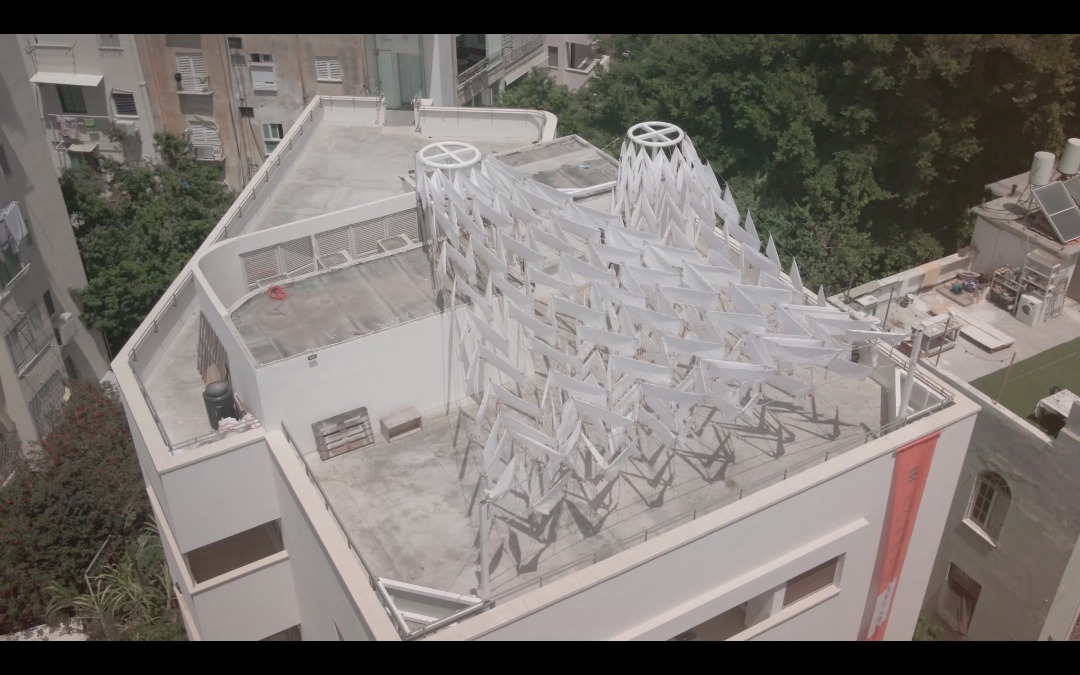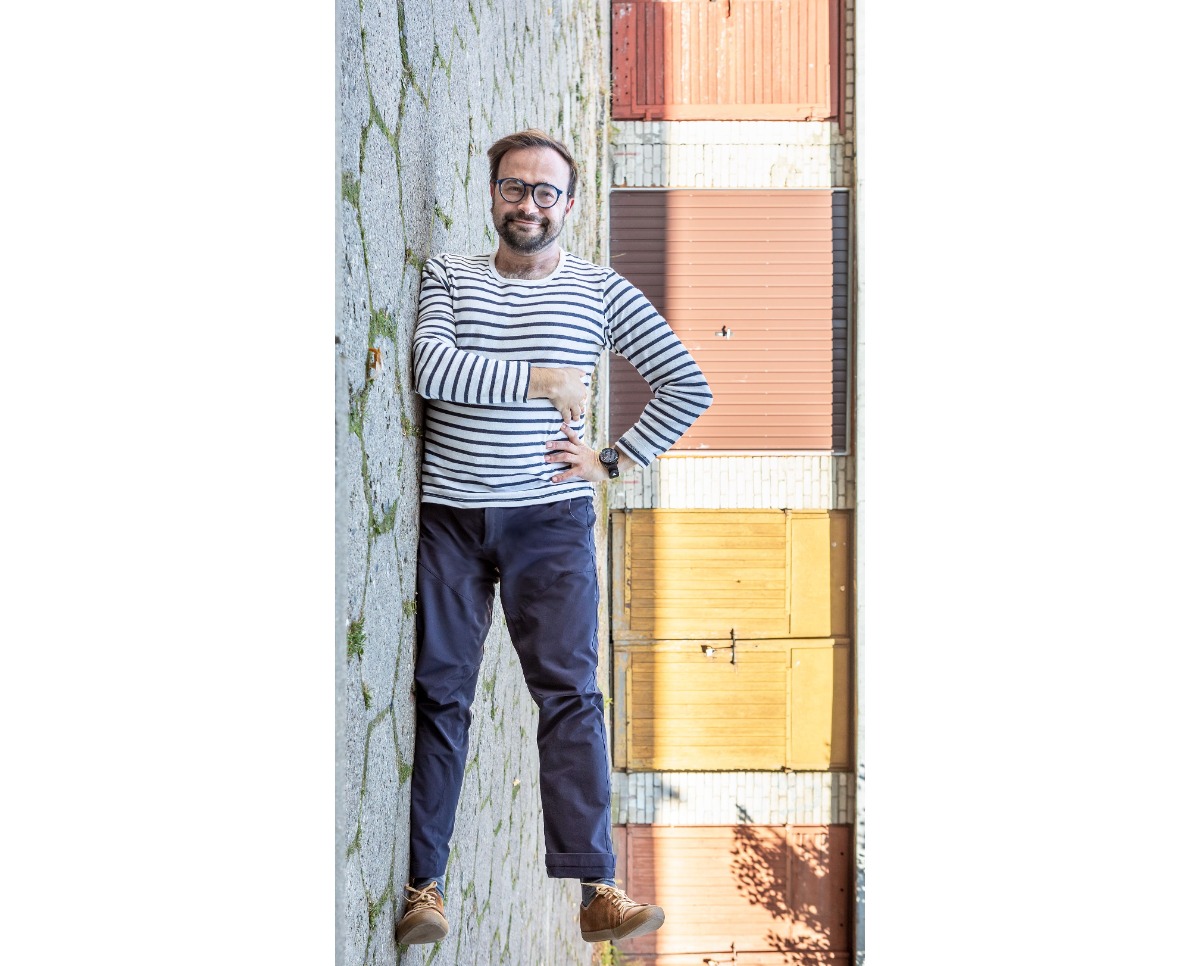
An exercise on limitation
An interview with Polish architect Jakub Szczęsny
Jakub Szczęsny (b. 1973) is a Polish architect, installation designer, and designer. In 2012 international acclaim was bestowed upon his project Keret House – a 14-m2 building that was a kind of urban hybrid of architecture and public art, elegantly inserted into a narrow gap between two other Warsaw buildings (22 Chłodna and 74 Żelazna). At its narrowest, Keret House spans only 92 cm, while at its widest it is 152 cm; equipped with the minimum needed for a functional living space, the miniature building has served as a residence for a wide variety of creative people. In 2013 Keret House also became the first example of Polish architectural design to be included in MoMA's independent collection in New York, as well listed on Iconic Houses, next to designs by Le Corbusier, Frank Lloyd Wright, and Alvar Aalto.
In a quite literal sense, the words “Less is more” make up the playing field where Jakub Szczęsny sets his professional aspirations as well as his platzdarm for inspiration. One of the specialities of his office, SZCZ, is micro houses, and as Szczęsny acknowledges in our conversation, the global pandemic and the resulting urban exodus (or return to the countryside) has only increased the demand for them. Various lifestyle exercises in the niche of “downsizing” are also a passion of his. In 2011 the architect designed a system of folding furniture with which he filled his own apartment. The scale and shape of the pieces allowed him to arrange a place to work, sleep, play and rest, all within just 21.5 square metres.
Szczęsny's studio operates in various design-related fields – from accessory-, clothing- and furniture design to exhibition-, interior- and building architecture. This large scope of interest comes from years of collaboration within the critical practice of Centrala Designer’s Task Force, a network that Szczęsny co-founded in 2001 with Krzysztof Banaszewski, Małgorzata Kuciewicz and Jan Strumiłło, and based on infrastructure provided by Studio DECO, the office of Jakub’s father, Ryszard Szczęsny. Since 2008 the younger Szczęsny has worked on a number of solo projects and collaborations with various architects, engineers, artists and designers, both in his homeland and abroad. He has won several architecture competitions and has designed, among others: a sports hall in Bieruń; Instituto Cervantes in Warsaw; and OHEL, the temporary pavilion of the Museum of Polish Jews in Warsaw. In parallel to his regular architectural practice, Szczęsny also works on interventions in public spaces in the Middle East, Europe, Australia and Latin America.
Szczęsny has broad experience working as a studio tutor, guest lecturer, and guest critic at a number of architecture schools, including The New School and GSAPP (New York), FAU (Sao Paulo), Bezalel School of Architecture (Jerusalem), IAAC (Barcelona), Warsaw Institute of Technology, School of Form in Poznań, and Warsaw’s Academy of Fine Arts Faculty of Design, from which he also holds a PhD received in 2012.
Szczęsny's style is atypical challenges and their equally atypical solutions. In addition to Keret House, he also has to his credit a gigantic flying-saucer-like chicken coop at the Saint Louis Science Center in Missouri, as well as a “temporary refuge” on the roof of Casa do Povo in São Paulo, Brazil.
Our conversation took place over Zoom. We spoke about visual, architectural, social, and thought-forming signs – both consistent ones as well as seemingly extraordinary ones – that this latest period of time has forced into the space of our world.
Jakub Szczęsny: I see you have a hammock there.
Una Meistere: Yes, it's from Brazil.
I love hammocks in interiors. They bring the life from the outside into the house. They create a feeling of being on holiday. I’ve always been interested in how people sleep in hammocks on boats. You know, traditionally, hammocks were used on boats. Even in Brazil, when you go on long trips on the Amazon [River], you have the lower deck, which is full, and the upper deck, which is just a roof on pillars to which hammocks have been attached. People sleep there in a row, right next to one another and only divided by a piece of textile. It must be quite strange – it makes me think of, like, an 18th- or 19th-century hospital.
Polish Refuge in Bom Retiro / congolese concert project by Jakub Szczęsny in Casa do Povo, Sao Paulo. Photos: Chico Davina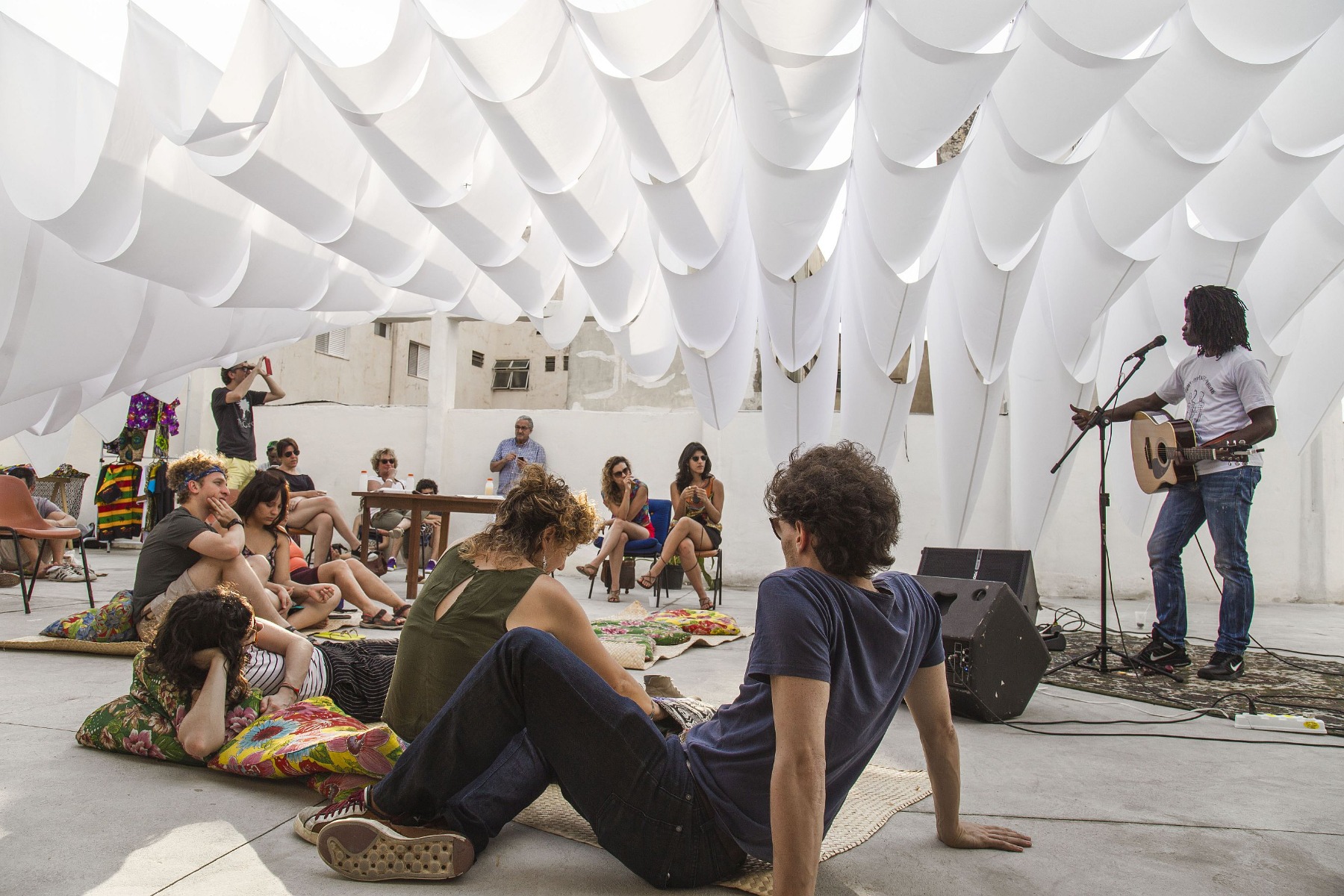

Actually, it is very comfortable to sleep in a hammock (and good for your back) – you just need to learn how to do it right.
Oh yeah. I've slept in many strange places in Brazil. I did an installation on the rooftop of the People's House in São Paulo. The money we got from the Adam Mickiewicz Institute enabled us to produce the installation under which I lived. I pretended to have my own salon and invited people to share the space with me. We had a programme for five weeks during which we have really revitalised the roof for the salon.
I'm very much interested in radical living – how do we adapt ourselves to radical limitations, and to what point are we able to change.
One of the tendencies we saw during the beginning of the pandemic – and which seems to still be ongoing – is people moving from the cities to the countryside. There’s a sort of building boom going on in the countryside.
Well, it's a global tendency, even in some places where you would not expect it – where people don't have this tradition. Here in the northern part of the hemisphere, especially in the Scandinavian countries and also in the Baltics, people are very close to nature. Having outdoor living is something very natural. Plus, you have very big chunks of space that belong to the government. Like in Norway, for instance, you can camp anywhere you want. But this tendency is also happening (which is absolutely shocking) in places like Turkey, India, the U.S., and Mexico. My friends from Mexico have told me that suddenly they’re having a boom in country houses, and micro houses as well.
Simple House. Photo: Bartek Warzecha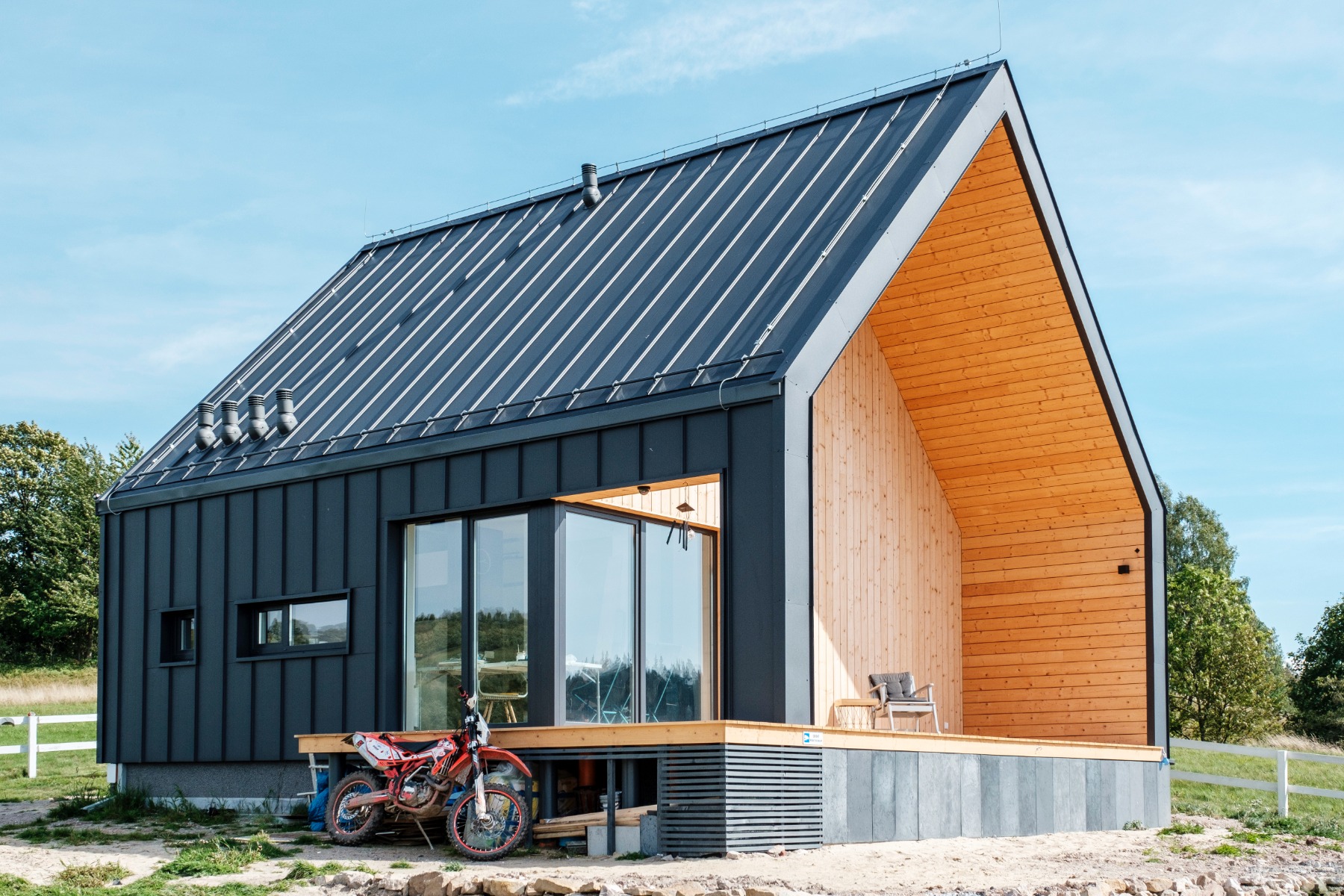
Actually, this is one of the tendencies that I'm very much into – you know, for the last twelve months I’ve been mostly designing micro houses. Whether we want we it or not, prefabrication is the future. What's happening is that, because of the legal limitations in many places, it's really hard to get a house fast. In Poland it takes almost a year to get a building permit, even for a stupid little house. But if you build a micro house that's only up to 35 square metres in size, there’s a different bureaucratic procedure which is simpler and takes only 30 days. So after 30 days from applying, you can start building. And suddenly you have a boom of micro houses, but really well designed. That is, for wealthy people who want to get a house fast. You know, like the urban middle class, who never expected to have a life in the countryside, and especially people with kids.
Suddenly the outdoor space, like Bernard Rudovsky [1905-1988, an Austrian-American writer, architect, collector, and social historian – Ed.] wrote, becomes an outdoor room. This is the main quality of the phenomenon, and it's really amusing to observe how people’s lifestyle is changing because, you know, you have to chop wood, paint things, get rid of old leaves, etc. And the perception of ambient temperature is also changing – you suddenly are more immune to lower temperatures. I think for many of us, globally, this will be a good thing, especially if you combine the trend with projects like 1000 huts in Scotland, where people get a permit to have microdacha on land that belongs to the government – as long as they participate in the programme by reforesting the area around their dacha. I think there are two good things going on here: people are going back into nature, and, people are restoring what we have been destroying for hundreds of years. So perhaps there will be some positives that come out from this whole Covid issue.
From your experience, how easy or how difficult is it for people to adapt to a smaller house? Because many of them, if we are speaking about the upper middle class, are used to huge apartments, huge houses with many bedrooms. Of course, when their kids leave, the houses often become empty, with abandoned swimming pools, etc. There are many such “ghosts”, also here in the Baltics.
I know – our countries share parts of 20th-century history. The psychological or even sociological mechanisms that are taking place in our countries are more or less parallel. The one that you just described is related to the fact that we've been, let's say, “curing our complexes” after living in too-small blocks of socialist flats. I grew up in a 54-square-metre flat, and my parents still live in a block of flats like that. Actually, it's really of good quality, because the good part of communistic thinking was to have all of the infrastructure in place. Everything is within walking distance – the post office, the shops... And people enjoy it because it's not about the size of the space that you own, but about the complex relationships throughout the whole area.
Simple House SIM 35_45. Photo Kevin de Maria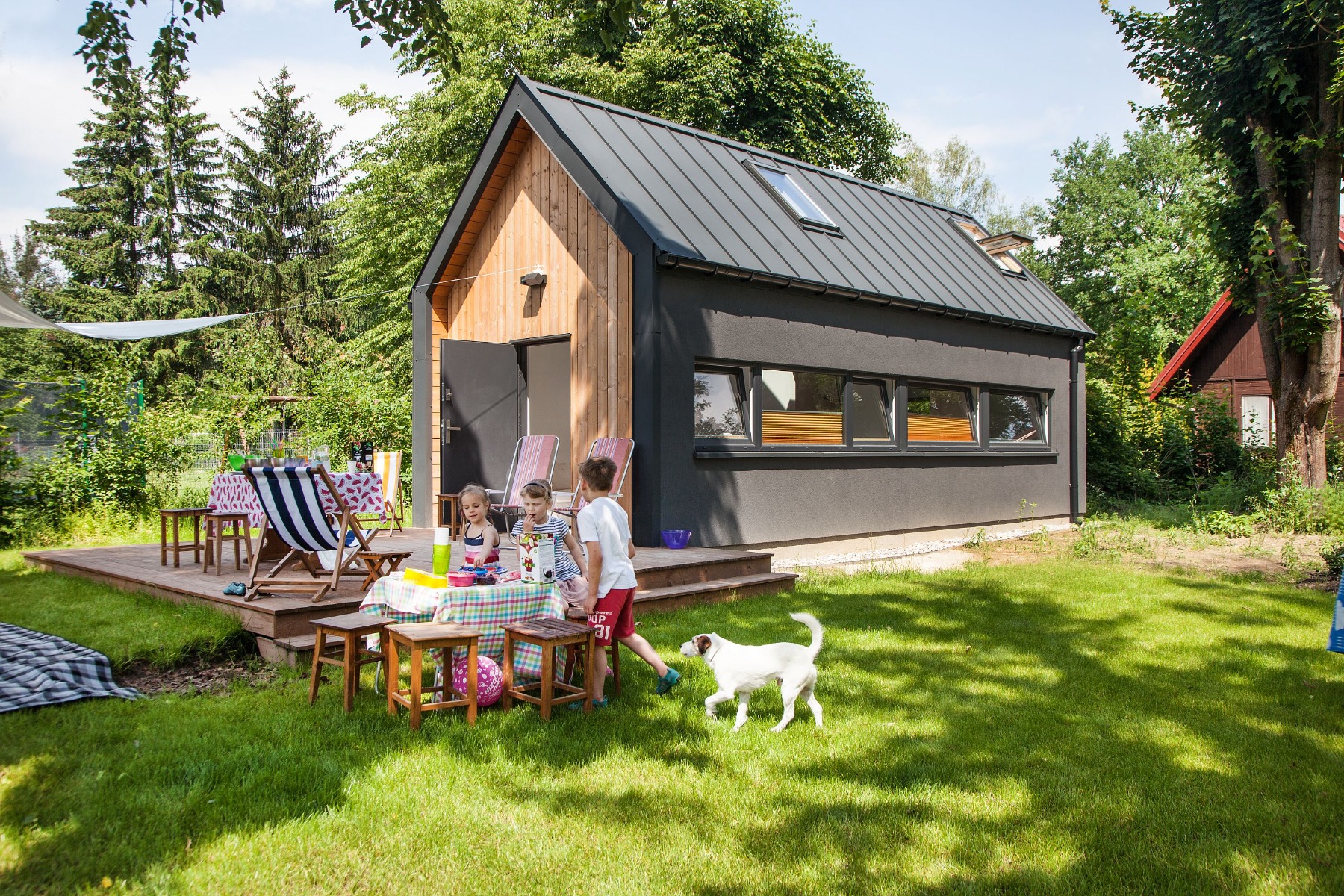
It's the same with micro houses – we finally left this period of curing our complexes, or wanting to become the Texans from the Dynasty TV series, which had great influence in Poland in the early 90s. This was the role model and the standards that we were thinking of. So we've been through it. Lots of people went bankrupt because of these appetites. Lots of people ended up alone in empty houses, especially divorced women in their 40s and 50s, like the mother of my ex-partner – she ended up alone in a 450-square-metre house with two dogs. It looked like a scene from Charles Dickens’ Great Expectations – a Countess living in a palace that she doesn't have the money to upkeep. She was just heating the kitchen and one room because it took a tremendous amount of money to run a house like that. It was the empty-nester situation: the kids went away, she and her husband divorced, and then you're left with something inappropriate for your new life.
I think we are done with that now. It's also related to the radical situation in which we now find ourselves, and I think we will be in it for the next year, at least (if not two), because I doubt that Covid will disappear that quickly. I'm not that optimistic. But I think that this is a situation in which people have become much more realistic when it comes to finding an equilibrium in consumption, in financial safety, and how to establish a certain relationship with a space and the ability to shape the space. Because one of the things about living in a small house is that it's not an apartment. You have to really do work around it, just like with a bigger house. So you’ve suddenly gone from this consumptionist paradigm of being someone who just rents or owns a flat, to having to interact with a completely different reality. It's no longer as simple as just changing a light bulb.
I think it's an interesting moment because one of the problems crucial to understand is that, over the last 30 years, there’s been a revolution in terms of a sudden augmentation in consumption standards. And it was radical. It's basically Margaret Thatcher and Ronald Reagan's neoliberal period. We're killing 50% of the global biomass; we’ve reached a moment in which we’re killing around 27,000 living species in one year. It's really a radical moment. And I think that Covid will help us to sort of turn the page between chapters; it will help us go to the next chapter in which, as with the last Oscars broadcast, we will see that reality is already different.
Of course, it will, as always, have both good and bad parts – I don't think we're going to get rid of the populists so quickly. I believe that the dictators will be doing as well as they were before. In terms of percentages, we’re not undergoing very big changes in the political and sociological education of the masses. I think it's going to pretty much stay at the same level we have now, which is about 50% of the people in most countries not really understanding what democracy is about – and not really wanting it, in fact. So some things will remain as is, but the good part is that most probably we will – as humans, whose main skill is adaptation – adapt ourselves to the new reality. One in which the positive part will be that we will be influencing (in a positive way) a more understandable set of spatial relationships – be it the house one lives in, the greenery, the production methods, or the landscape. And we will probably also change our relationship with space when it comes to mobility. Because up to now we've also been augmenting our mobility. With cheap flights, we’ve reached a moment in which we’re travelling all the time and in all directions. Airplanes and cars are the biggest carbon-footprint producers, which is why I think that we will see a really interesting phenomenon taking place now, one that is related to having interactions in smaller territories.
Gustaw Zieliński
Square by SZCZ Jakub Szczęsny. Photo: Evgeny Tkachenko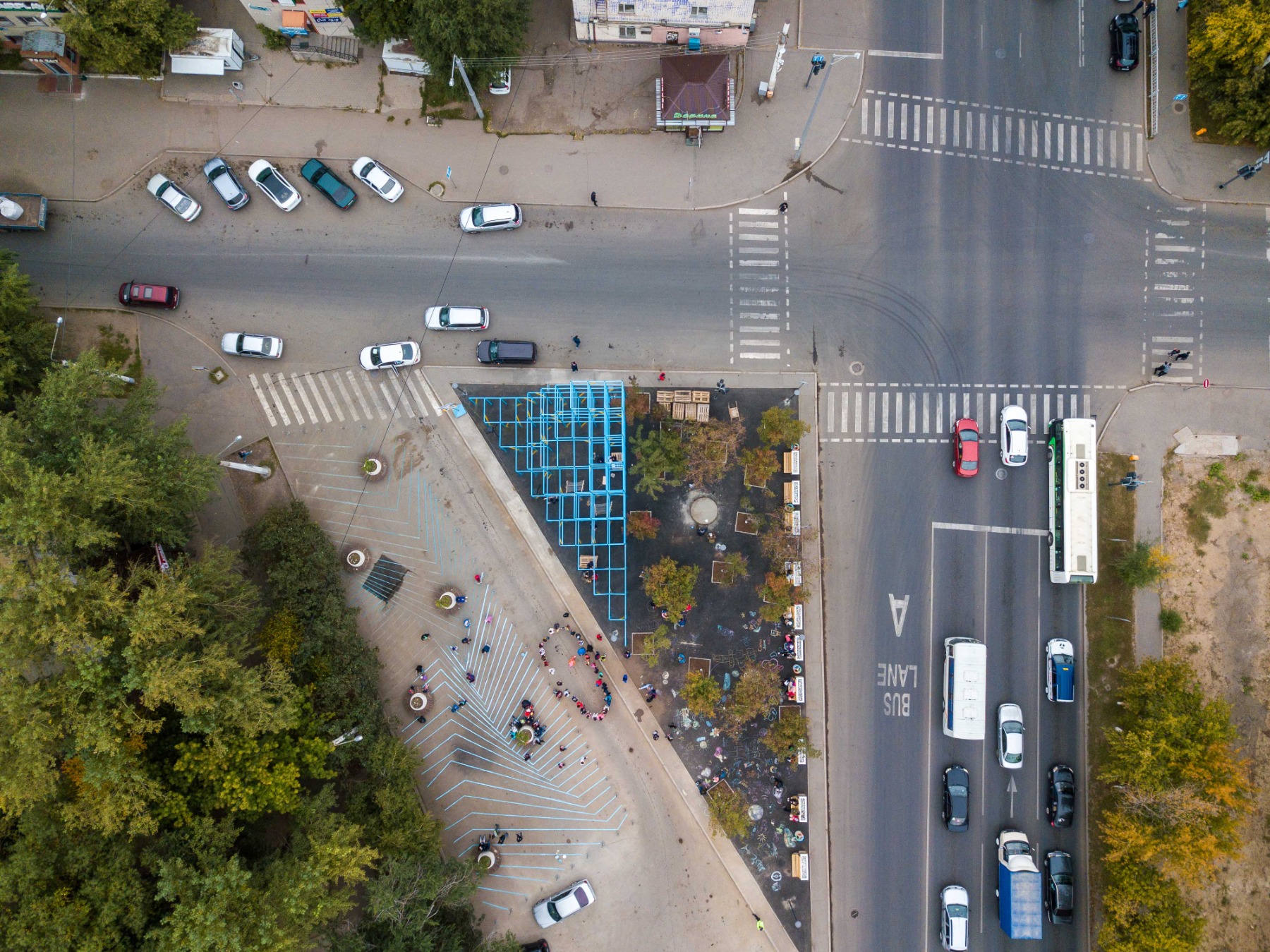
This was already happening in villages around Warsaw even slightly before Covid – in villages that were dying out because the old people didn’t really have the possibility of passing their houses on to anyone because the young people had gone away and didn't even see any prospect in selling the houses after the old people were dead. But what was happening is that suddenly there was a movement of people because of the internet – people who were able to change their work habits. They could just be in the city for one or two days a week, and the rest of the time they could work online. This changed relationships, not only in terms of the prices of these houses or plots, but also in the bonds between people. Villages started to become more of a hybrid situation, one in which you buy your eggs from the old lady nearby who has been there for many generations, and so on.
Gustaw Zieliński
Square by SZCZ Jakub Szczęsny. Photo: Evgeny Tkachenko
For instance, the place where we live is called the Golden Crest. Which is actually funny, seeing as we really have the aristocratic emblem of an Italian family (Orsetti) who bought the grounds in the16th century. In the 1920s they wanted to create a garden city there, but that never happened because the war started. You know, we have a set of garden cities around Warsaw, which is interesting because we are sort of going back to the idea of garden life now. There's lots of empty ground there that was overgrown by very dense forest, but suddenly it’s coming back to life as all kinds of “free professionals” (lawyers, artists, etc. that don't have to go to work every day) have settled there. There's much more solidarity happening, starting with commercial interactions – something that I thought we had lost forever. For instance, at the start of Covid-19, the woman who runs the village started a Facebook page that brought together the villagers with the surrounding farmers. They created a system in which the local farmers simply left fresh produce in front of your gate and you would pay them online after having received the goods. Before Covid, something like this was unthinkable in Poland, because in Catholic countries people don't trust each other. It was a radical change, and it worked. And similar things are happening in many other aspects of daily life where in the past, any change at all was simply considered impossible.
UFO Chicken Coop by Jakub Szczęsny. Photos by Dave Callahan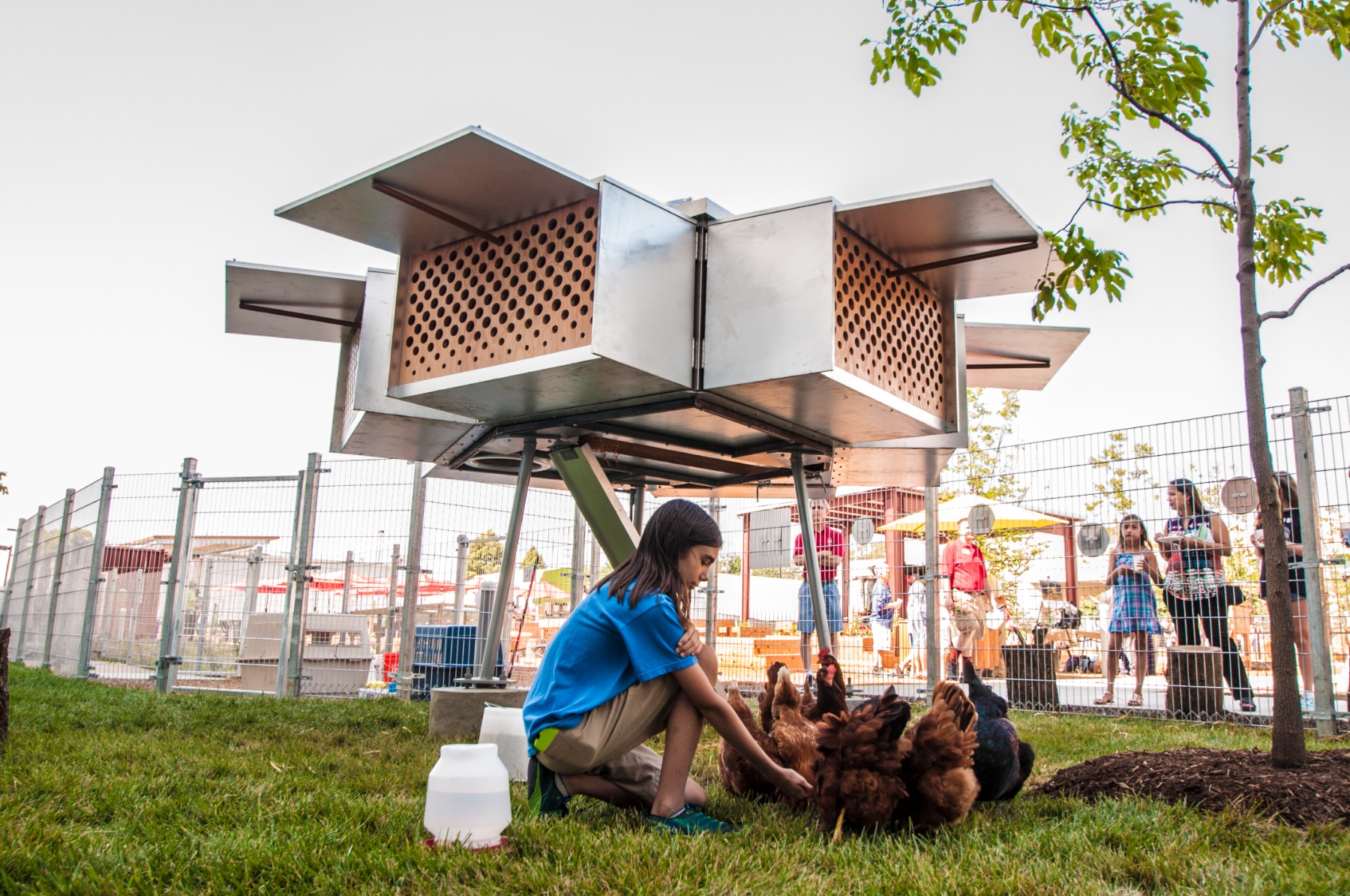

What do you think could be the future of big public buildings, the so-called public landmarks? Here in Latvia we still have quite emotionally saturated discussions about the necessity of a new concert hall. In the meantime, there’s also the question of the sustainability of those huge buildings.
You know, I have a problem with big things in general. Because I think that many of our big ambitions are related to our big complexes. And it's not really helpful when you realise that our ex-Soviet or ex-Russian past is producing complexes in us that cause us to want to have big public institutions of the kind that we didn't have before. In Poland, we didn't build any museums during the entire communist era, so suddenly because of EU money, there's a burst of philharmonic halls and museums being built. It’s fantastic architecture sometimes, but the question is not “How?” but “What for?”.
So if we step back, another question is – is it good that we have linked architecture with tourism? It’s a throwback to the 1980s, when urban marketing as a phenomenon was described and different mechanisms were put in place, and also because of publications by Deyan Sudjic in Blueprint* magazine in London. This mechanism of “let's build something big that has a ‘wow effect’, so that Chinese, Japanese, Americans, etc. come and leave their money in restaurants, hotels, and so on” is actually tremendously harmful by the end of the day. You can see it in Barcelona, which, thank God, woke up from this type of thinking at some point; the same goes for Prague. They were places that became unbearable for their inhabitants because of the deluge of tourists and the pro-tourist logic of the municipality.
I think we are changing this type of thinking now, and I also believe that the period of many big buildings is over. Municipalities already see and feel that, in most cases, it will be a burden and a problem to run them. Even if a specific building didn’t have to be kept at +22-24˚C (the norm for most of these kinds of interiors) during Covid-19, but only at +6˚C, it's still an expense. For example, when we were in the middle of the most stringent lockdown, if you drove through Warsaw and looked at these huge skyscrapers, these buildings were fully lit – even if no one was inside them working and the streets were practically deserted. It was a kind of magical thinking that life is going on as usual – we are not closed, we are alive. Imagine how much money it cost for all the firms that rent space in these skyscrapers. What for? A lot of it is psychology, basically, a manifesto of nothingness.
Because of certain EU mechanisms, we developed a type of thinking in which we've been overproducing architecture, especially public architecture, and overproducing culture. There was too much “culture” happening, but no one would say this out loud because, you know, we all thought that culture is a good thing – it's like money, it's like a good expression of humanity. The problem, again, is not “Why?,” but “What for?.” How large are the groups of people who are able to receive this culture and are prepared to deal with it in any way? I can tell you that in Warsaw, the gallery-goer group is, at best, 5000 people. And the entire city, with surroundings, is about 2 million people.
I think we are dealing with a problem in which we didn't really act where it was necessary to take action. The most important place we should have taken action was actually education. Especially in Poland, you see it in almost half of society backing the populists who are, out loud, saying that the Enlightenment in the 18th century was a mistake, that we should go back – not even to the Renaissance but to the Middle Ages. Even some intellectuals are saying things like, Yes, let's go back to the Middle Ages; let's chop off heads of people publicly, it will become an exemple, a form of moral education. And why? Partly because there was never really any big educational reform. None of the politicians in the democratic Poland after 1989 really did anything meaningful with it because it was deemed as too difficult. And now we are reaping the fruits of this inaction.
So I think that for politicians, especially for local politicians, it's really easy to say, Hey, let's build a museum – we will get EU money, it will be fantastic. Because it's a cherry on top of a cake; it's something visible, something that produces an icon. So suddenly your place, which may not be all that interesting – i.e. a post-communist reality in which you can only repaint horrible buildings or hide them behind trees so they are not as visible – builds itself a new philharmonic concert hall, and now you can say, Look, our city has a philharmonic concert hall!...
We have a very good example of this in the small town of Kutno, where the municipality, with a panel consisting of old-generation architects, held a competition for remodeling the town square. But what they actually did was kill the town square – by putting a one-level parking garage in the middle of it, and supposedly placing the town square on top of it. As you may have already guessed, it doesn't work at all. It's basically a garage with a dead roof with dead pigeons, and lots of granite. They've produced a cushion of hot air during the summer, so nobody wants to be there. But the architects were very proud; it looks very nice.
In pictures.
Exactly. I think we have also finally stopped thinking about the environment as something that depends on an image-related element. The fact that this year the Pritzker Prize was given to French architects Anne Lacaton and Jean-Philippe Vassal is basically proof that we are done with the “Zaha-Hadid period” and that way of thinking. Let her office destroy more Asian cities if they wish, but we are going in a direction that makes much more sense. Because it's about context; it's not about sexy and expensive sculptures that you put in your space.
I think we are in the middle of a big change on many levels. The crucial issue is that we have to focus on context, on going back to understanding reality not only through spaces, not only through budgets or political interests, but also through much more subtle elements, starting with climate interpretation (how the climate is influencing our activities) and ending with psychology. What is our relationship with biology, what is the ecological part of it? It should not be misunderstood as a kind of “pornography” of expensive eco-solutions, but as limiting our appetites, our needs, expenses (energy expenses, etc.), and even our behaviours.
For example, I started an exercise in trying to use less water. You never know how much clean water we might have in the future, right? So I now brush my teeth with a very small amount of water. Very fast – you know, get the paste on the brush and then just one sip of water, and that's it. Like really minimising it. And I've changed the valve in my shower, too. I now have a mist of very small droplets that is not very dense, and I end up using radically less water. It didn’t really do this because I'm obsessed with ecology, but rather as a sort of exercise in limitation. And then I started going further. I love coffee, so I bought a manual coffee bean grinder instead of using an electrical one.
I worked for a year and a half doing an artistic residency for General Electric in Louisville, Kentucky. And I understood that every American thinks in terms of cheap electricity. This is why the map of electricity use and lighting in the USA is so strong – they want to electrify everything. Even worse, they want to put a robot into everything. Basically, I was asking the question of why, at the end of the day, would you want to be a feeble body but with a big head? Do you want to really decrease your capability of remembering things? Because that is what will happen if you put microchips in every refrigerator so that it can remind you that you need to buy milk, etc.
Basically, I think limitation is important, as is going back to the action of manual ability. Actually, a funny thing about the coffee grinder is that it wakes me up in the morning – because when I go into the kitchen, I’m still really groggy, and physically grinding the beans instantly gives me a burst of energy.
A lot of things that we are surrounded with could be mechanical, and it wouldn't kill us to operate them ourselves.
Taburete Towers in Bangalore
I don’t know if we are lucky or unlucky, but we are in a very interesting moment in history. Are we going to screw it up completely by destroying the earth? I don't know. Maybe, maybe not. Speaking about myself, I started to reconsider many things that we think of as having value. For example, art biennials. As we know, there are tonnes of biennials because the biennial is the equivalent of the opera hall in the city – it forms part of the urban marketing. Especially in Venice, which otherwise would be a happy city without all these people. So what happens is that you have all this incredible industry of art, of culture in general, in which things are tremendously important during this event that lasts for three or four days, or, like in case of the Venice Biennale, a couple of months. And then they lose importance – from 1000% to zero – and they end up in the trash or in some seedy storage space. That’s why I developed the idea of Taburete Towers, which I did for both the Concentrico International Festival of Architecture and Design in Logrono, Spain, and the Bengaluru ByDesign festival in Bangalore, southern India. The idea was to create an object, so that you have a “fetish” during the festival that people come to see. This “fetish” is made out of separate pieces that are actually stools or taburetes, and the people who were present during the finissage had the opportunity to receive one for free – in a sense, they brought the festival home with them, as both an object and a memory. It’s something we all want, and it’s why we produce all these gadgets, albums, etc. – everything that is left over from the festival.
It is really painful to realise that we are able to recycle just around 12 to 15% of everything we produce, with the rest becoming trash. I believe this work gave a broader perspective to the people who saw it and received one of the stools.
Taburete Tower. Photo: Peninsula, Josema Cutillas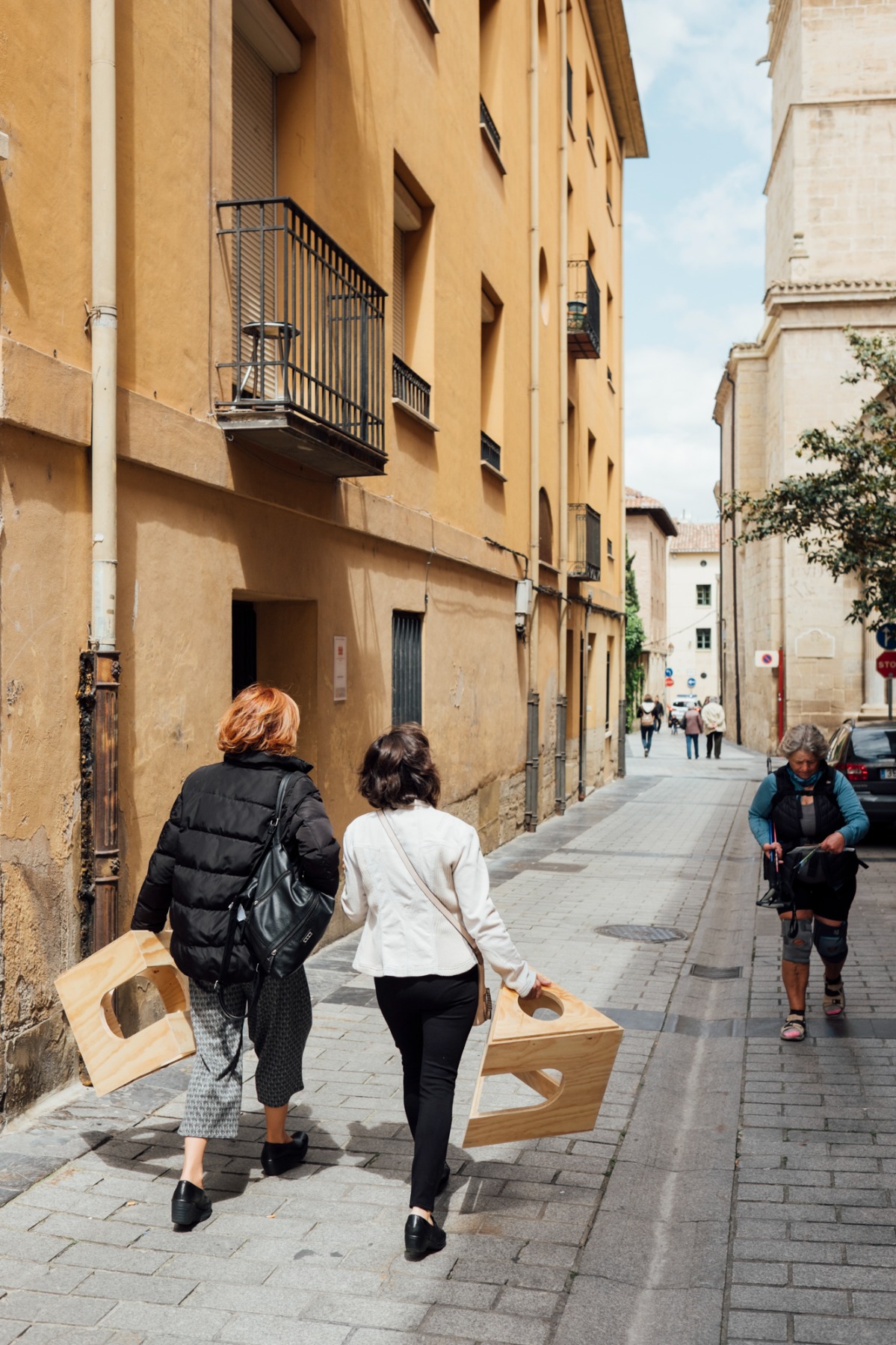
That's a beautiful idea. But returning to micro houses, one would think it's a challenging niche for an architect. I suppose that as a platzdarm of creativity, the micro format is a more complicated exercise than regular- or even larger-scale projects.
Yes, and there's a bunch of layers in it, like in everything.
The “ego issue” is also present, I would guess.
This is one of the problems, how to deal with the ego. Because we become architects or artists precisely because we do not want to sit in the corner, or be a shadowy persona. On the other hand, we have to remember that, especially in architecture, it's actually a service profession.
In my case, I was always (since the second or third year of my studies) obsessed with plans, and this continued up to spatial three-dimensional configurations – I always loved to play with planning and constructing. The other thing is that ever since childhood, I have loved to hide; it’s because during the state of war in Poland, my parents were in the Solidarity Movement and they had to hide the illegal Solidarity Union magazines. If the secret police or milicja at the time would come to our home, they would seek these kinds of publications. So my parents hid them in various creative places. During WWII, Polish Jews would hide in these kinds of places.
Keret House. Photo by Bartek Warzecha
One of these traditional hiding spaces was called a pawlacz, which is a space or storage area that is located above the door. Sometimes, especially in 19th-century apartments that have very high ceilings, this hidden space would be as tall as the height of a human. It is like an extra mezzanine that is not very deep; it’s very interesting because it's like a stalla in a church, the niches and niche-alike benches for the statues of saints. My friend inherited an apartment like this with a huge space above the door, and she found a chair standing in the middle of this space, as if the person who used to live there had used it for sitting. It's a very obscure place to sit – you need to climb a ladder to get up there and so on.
So I’ve always been fascinated by these kinds of spaces and how to do something with them, and by chance, with micro houses you need to have this sort of an approach specifically because there is so little space. You realise that people will actually be eager on changing their standards on space availability – it won't upset them if the stairs are much steeper, or if they have to use a ladder instead of stairs. Things that they would consider impractical in their apartment or in a big house are now tolerated. With this in mind, you can go into a logic of designing an interior in the manner of a yacht or a spaceship, or even a camper. Suddenly everything can be smaller. It's an interesting level of the game when you realise that you are not forcing people to live in a smaller environment, but that they are actually okay with it.
Keret House. Photo by Bartek Warzecha / © Polish Modern Art Foundation
The middle class is interesting because they still need “fetishes”. You know, it's like Zygmunt Bauman wrote – the best way to describe the middle class is as liquid modernity – they are always aspiring to a slightly higher level; not very much higher, but the next level. Because we are very practical, we count every penny and look around a few times before we spend it; we need some proof that we are slowly climbing the social ladder. And this proof comes in the form of “fetishes”. One is a Smeg refrigerator; another is a Nespresso coffee machine. It's quite funny because suddenly you have to squeeze these fetishes from the apartment into a new micro house. The rest can be small, but when they look at this refrigerator that they’ve bought, they feel that they have achieved “success”.
That’s why I love this moment and observing us as a class. What are our material world references? What are our thoughts on safety and comfort levels? Because these are the basic things that we build our worlds around. And you can observe these funny fluctuations, some of which Covid-19 is creating.
Like the impossible concept of safety.
Of course, to create a construct you also need the tools to keep it going. Just before our conversation I went to the nearby bookstore – my son is 18 and suddenly he wants to plan his life, have a calendar diary. I asked the salesperson what they have on offer, and she replied that the options are very limited. I asked why and she said that since Covid-19, the market demand for diaries has gone down, and it's not because of digital calendars. Most likely, people are thinking more about their mortality, memento mori… death can come at any moment, so why plan anything?
Keret House, the street view by Tycjan Gniew Podskarbinski, © Polish Modern Art Foundation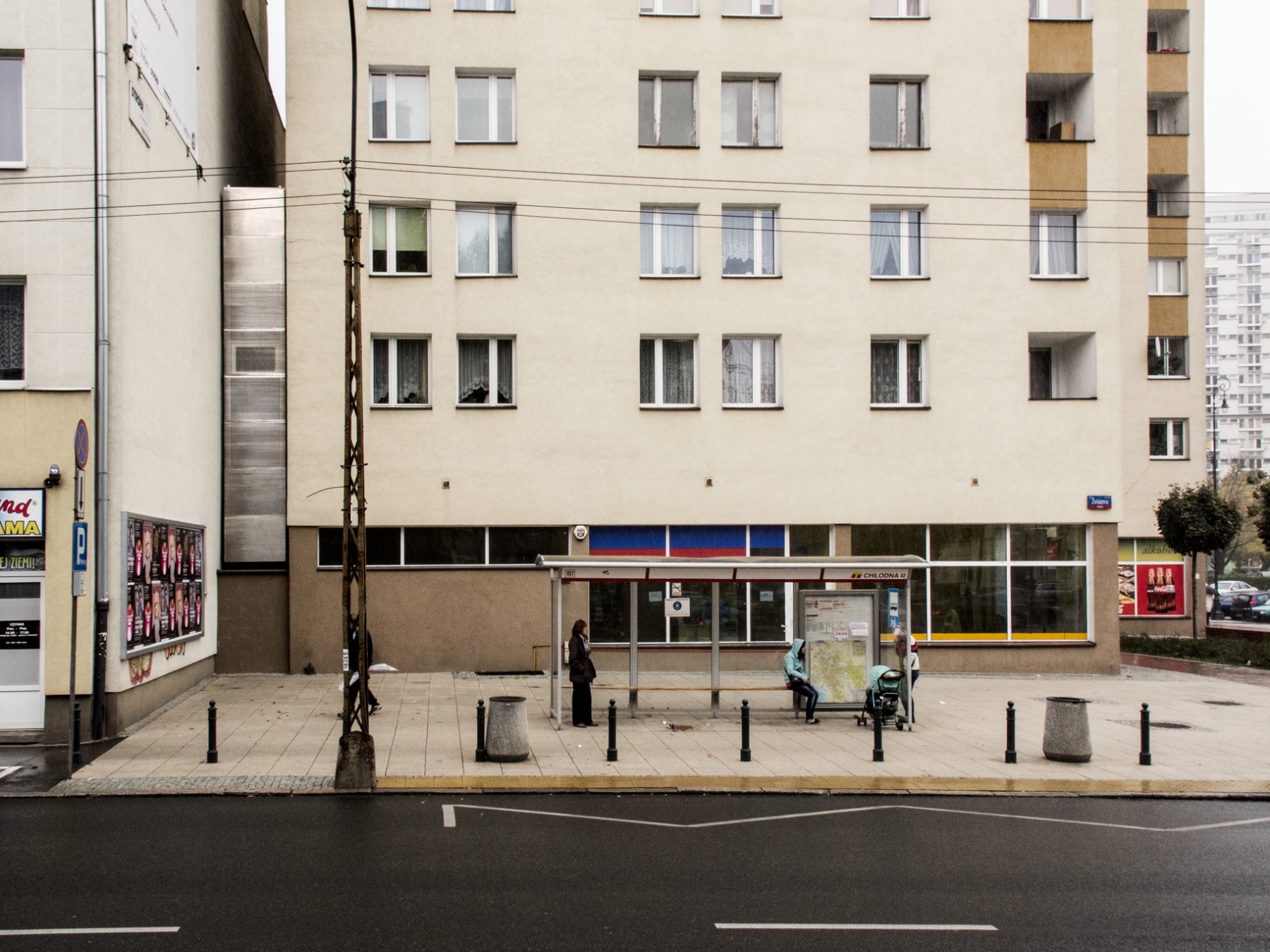
That's true. I also wanted to ask you about Keret House – is it still there, and how has its story unfolded since it was installed?
It was started as a project that was supposed to be practical, something that really works. Since the beginning, the Polish Foundation of Modern Art, who both owns and administrates it, planned to make a residency there. The residency started just after it was opened, and it worked for a couple of years. Very interesting people stayed there. The first one was Chuck Fishman, a Polish-Jewish photographer from New York who is obsessed with Poland. He's photographed all of the Popes’ visits to Poland… a very interesting guy.
Then there were musicians and composers like Macio Moretti and Marcin Masecki with friends, who used the building as an instrument, as a reverberation box. So we've had all kinds of people who have been interested in Polish reality but who didn't need much space to work.
Keret House, the street view by Tycjan Gniew Podskarbinski, © Polish Modern Art Foundation
But at the moment it's closed, right?
Yeah. But, you know, I was getting feedback from the people living there, and they said that the place was absolutely perfect as a hermitage – as a place to run away from reality.
I'm a father of three sons: 6, 9, and 18 years old. So, as a person who not only has a daily architecture practice, but also does artistic projects that are on the verge of architecture, as well as writes and teaches... I need places where I can run away to.
Before the younger boys were born, I would go to art residencies all over the world; I did this for ten years. But then I started to have an office just for myself, a place where I could remove myself from the kids. I was very much used to working at home, but it just wasn't possible anymore.
I then understood how many people have to deal with this problem every day – they need to focus but they can't because there are so many distractions, from telephones and laptops to other people and our loved ones being around us. So I thought about Keret House as being like an ideal bubble in which you are cut off from reality, but at the same time, it's quite easy to go back to that reality when you need to.
Some years ago I was at Schloss Solitude in Stuttgart, in residency. One of my neighbours was Polish writer Mikołaj Łoziński, and he said he has a system in which every two weeks he goes back to reality. He sits and writes for eight hours a day for two weeks, and it's perfect. But after this period he needs impulses – impulses from real things, not TV or Netflix. So he takes a bus to the nearby city (or even Warsaw), and just fills himself with experiences. Then he goes back to the Schloss to sit and work, day after day... and repeats the cycle. This was the kind of dychotomy that I wanted to embrace with this project.
Do you think that the post-pandemic reality, as well as the pandemic itself, are going to change the role of art in the public space?
Definitely. I just don't know in which direction. I think one of the directions will be hysterical socializing. We will start to mingle, to interact hysterically. And this can go in different ways.
I’ll give you an example. I'm doing various public projects in Brazil, and so I’ve gotten to know many different people. One of these friends, a gay curator and activist, told me about this new phenomenon that emerged during the pandemic called “horse stealing”; I think it's very representative. It goes like this: because of Covid, people who had previously had a high level of physical interaction with others (and this is what public spaces are about, right?), who had a very developed sexual life – like swinging, gang bangs, etc. – The March of Rememurned to the internet. They basically organised orgies on the internet. So couples or individuals would do Zoom calls with all these windows, having sex together but through the internet. I can imagine this working because people have already been watching pornography on their laptops and getting excited by it for quite some time now, so why not do it with real people interacting in real time? A part of the appeal was that people on the other side of the world could suggest to other people in one of the the small windows on their screen to now please do this or that for us.
If we take this phenomenon to the realm of public spaces, I think that this is a kind of a perversion that's going to happen with public spaces – something that we've never expected to happen. A hybridised format of some sort.
SPACE installation
within Lechstarter CSR programme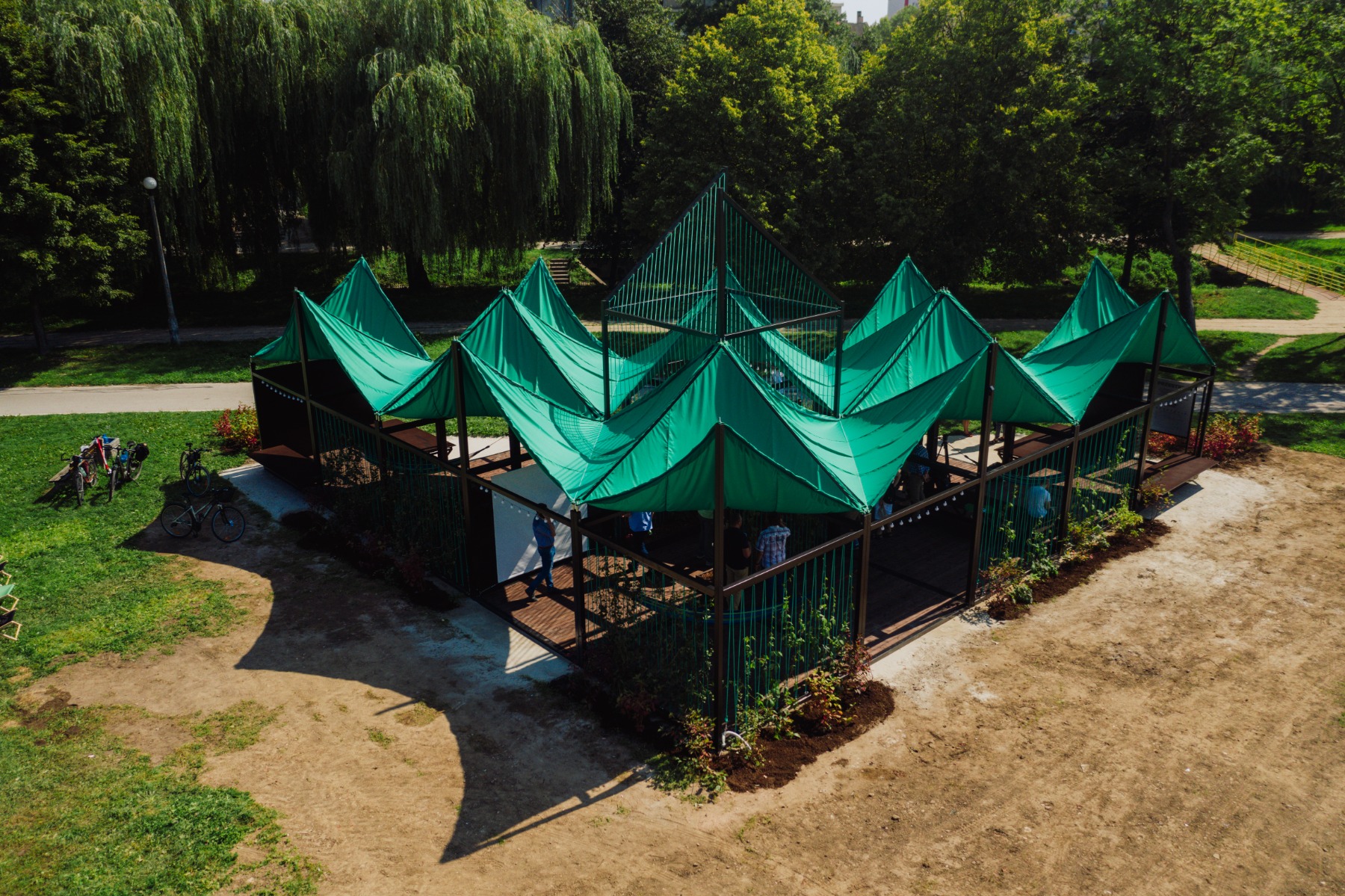
Right now I'm working on an installation that will commemorate the Ringelblum Archives. The Ringelblum Archives are a collection of 1680 archival units retrieved from the ruins of the Warsaw Ghetto. The Archives comprise government documents, materials concerning the ghetto resistance, testimonies of the fate of Jewish communities during the Holocaust, literature, works of art, and private correspondence collected by victims of the Holocaust in order to pass on information about the Holocaust to future generations. The documents were collected by a group of professors from a gymnasium that was within the Warsaw ghetto. When they knew that the ghetto was about to be closed, which meant that most of the people inside were going to be taken to their deaths, they dug a hole in which they put two milk cans with all these papers inside.
Every July 22, which was the date in 1942 when the liquidation of the Warsaw Ghetto began, there's a big event called The March of Rememberance, in which people walk together carrying ribbons with the names of the deported and murdered. The march ends at an installation that is a sort of temporary monument. We were discussing the upcoming installation, and I saw some stress it’s causing in the Jewish Historical Institute, who is organising it. Because of Covid it's not that obvious how to manage it this year, or what kind of format to use, because in previous years the manifestation has involved up to 2000 people. Say, there might be imposed restrictions that they haven’t had to deal with before, like keeping a distance of one metre between people – or maybe 30 or 50 centimetres. Or maybe even four metres...who knows?
What the consequences of the pandemic will be is probably not something we can really fathom or expect to know right now. In the meantime, we keep on being sort of creative monsters. Especially in Poland, where we are used to dealing with oppressive reality. Historically, we've always been under the boot of someone – Russians, Prussians, Austrians or our own aristocracy, catholic church, not to mention Russia-obeying Communist Party or Putin-inspired Polish nationalists. When you look at our history, this is probably one of the last places in Europe where the feudal system finally came to an end. Consequently, big chunks of our society are used to oppression, and in turn, overcoming this oppression in different creative ways. So I'm completely sure we will manage, in some way or another.
The Fifth Space at Lieblinghaus. Photo Yael Schmidt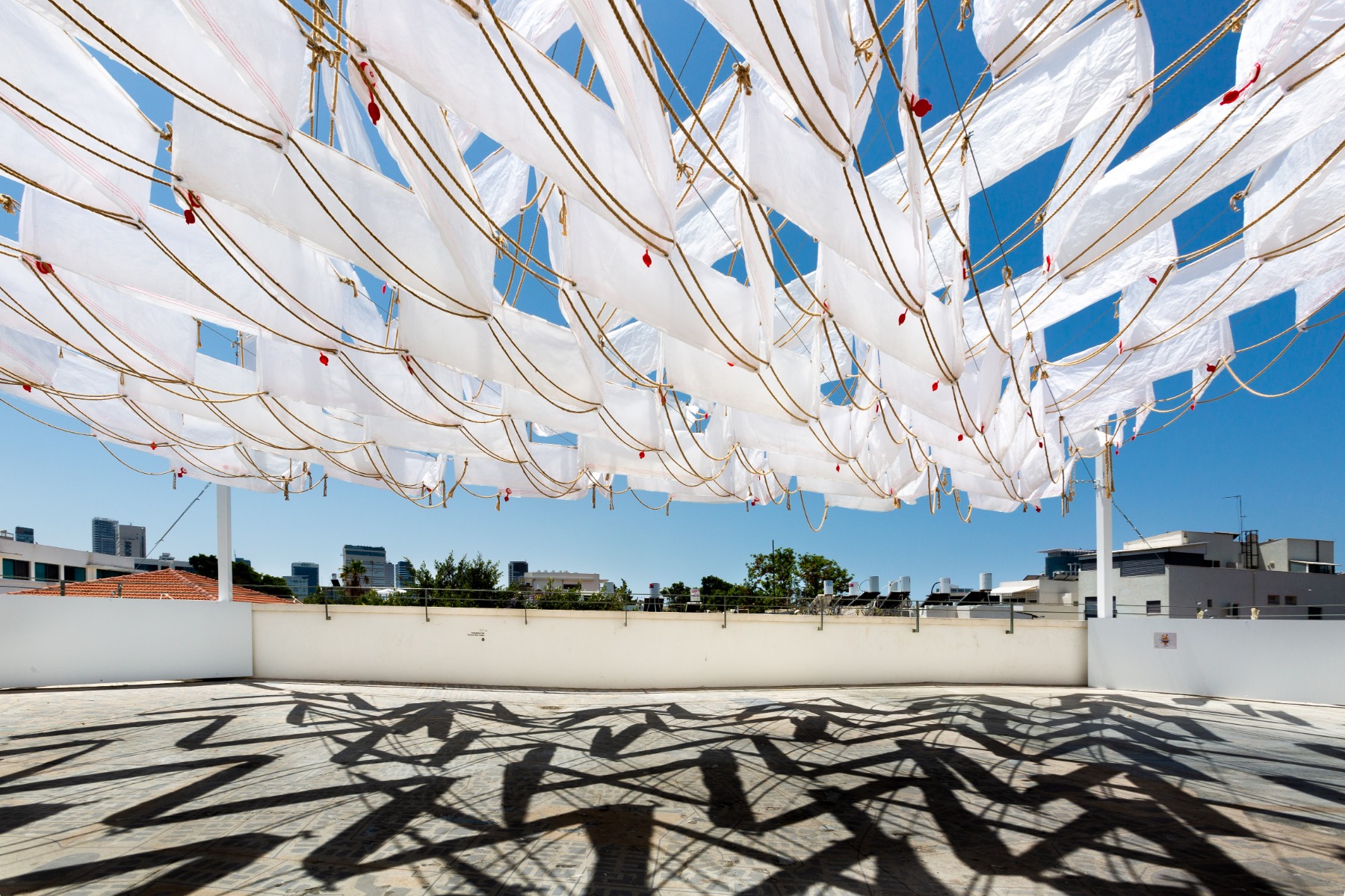
In thinking about the transformative aspect and creative solutions, once this pandemic is over, what will the environment we live in be like and how will it change? Taking into account the fact that the virus is not going to disappear, and that future pandemics are likely to follow, we will have to accordingly adapt and reorganise both our public and working environments – e.g. ventilation issues, the future of open offices, etc. – so that these environments do not become clusters ripe for mutations or even new viruses. How ready are we for a transformation of this kind and scale?
Elasticity is crucial in our existence, and the elasticity of different formats of usage is the only way we can save what has already been built. Personally, I think that we will also have to destroy many things or leave them to die... or in some cases, give them a new life. It's very paradoxical that in Poland (where we have around 36 million inhabitants) we have the lowest birth rate in the EU, yet we have an overproduction of architectural buildings and especially offices. Who are they for? Somebody is going to have to come up with an idea on either how to change the work format (which will only fill a part of these office buildings), or how to turn them into residential buildings – which will require a bit of a hustle because there’s the legal issue of different qualifications for office buildings and residential ones. But it's doable.
I think the main thing is that we are already working differently now. Even in corporations we can observe a drastic change in the perception of what is work efficiency – CEOs have come to realise that they don't need to own buildings; they don't even need to rent buildings. They just need spaces for briefings, and sometimes for team meetings. It's amusing to see these people come to this conclusion – Hello, we don't have to operate like a 19th-century factory in order to have our people working efficiently. I think this is one of the formats that will influence the built environment – we will see fewer big office buildings.
It’s a fantastic moment for us to reconsider many things that we believed were givens, or that were stable. Nothing is stable, like with these calendar diaries. It’s also why we have so many divorces, for instance. I have lots of friends who are lawyers, and the best money to be made today is in divorce law – because it's a trigger moment. If something in a relationship was not working, or was in a plateau phase, when Covid came on the scene people were forced to reconsider things. And they came to the table and renegotiated, or they split, or whatever. I worry about my kids – will they be able to adapt themselves in the future? They will, I'm sure of it; we can give them the skills to adapt in different ways.
The Fifth Space at Lieblinghaus
It's a time for people with courage. I’ve observed this in the realm of business. I deal a lot with business people at different levels, and I see that they have basically two approaches. Either they duck down and lower their profile as they try to survive (which I think is not the way to go), or, they’re the kind who will take risks because that’s just what they do in radical situations. This is when crazy ideas come out – from whatever sector, whatever base. Because those who want to do something interesting now feel justified by the reality they’re facing.
We will do fine, but things will be different. Also in the art world. Each time I’ve been in New York (I did residencies there twice and my project has been excibited at MoMA), I observed something that I considered a “pornographic” pathology within the gallery system – artists who only run around the money. When you go to an opening, they all talk about either money or the fashionable motives happening at the time – either race- or gender-related – and nothing else. You see a very large number of people who are making money off of art. I believe if this part of the sector would die or shrink in size, it would do these artists good to produce less as artists and to do what they do in a wiser way... as well as do other things in order to survive. In my case, it is the perfect situation for me to combine being an architect, designing clothing, and having art projects because all three genres synergistically feed each other.
With the onset of the pandemic, many of the brightest minds of our time have mentioned the need for a “new Bauhaus” or a “new Black Mountain College”, because to them it is clear that the only solution to the current crisis and a sustainable future lies in interaction – a synthesis in which science is in dialogue with philosophers, artists, architects, historians of ancient knowledge, politicians, religious leaders, etc. Interestingly, the EU quickly caught on to this idea, with talk of the New European Bauhaus (already a politically conscious initiative) going on in the corridors of Brussels. Is a “Bauhaus 2.0” possible? Can it be created from the "outside"? Are the preconditions for such an initiative possible in a world that is still slowly crawling out of the pandemic? And finally, is this the right way to go about it?
For now, I'm observing it; because if it's going to work, it has to be a long-term thing. We have to remember that a part of the success of Bauhaus was precisely because of politics. And just as precisely – because it was oppressed by Hitler. And also because the American government endorsed the Emergency Rescue Committee that helped in evacuating some 2000 intellectuals from Vichy and other Nazi-dominated zones of Europe. These people then became the prime influencers who transmitted the Bauhaus and European modernist ideas to the U.S. as they became teachers and educators, from Black Mountain College to NYU. They became designers, architects, whatever – very influential people. In large part because of them, the U.S. came out far ahead of the race in terms of quality in industrial design, in architecture, and also in the theory behind it all. Regarding today, there are many things that might become perverted on the way because of political reasons; politics could help, or the other way around – ruin an initiative of this sort.
Jakub Szczęsny at the Polish Refuge. Photo by Leo Careme
I think we are in a special moment, and this moment needs special measures. And these measures have to be integrated. We cannot work as individual, sparse points on a map. So I understand the need for integrated action that requires a political level of administration to radically change many things. Starting with how we direct the money to what kinds of processes are undertaken. And with a focus on creativity because actually, a lot of things have been screwed up due to over-creativity. As humans, we need to produce all the time – everybody from a factory owner to an artist. Once you are in the loop, you have to be productive, and the logic of the capitalist system requires you to be in it. And, of course, productivity means resources and extracting these resources, and by the end of the day, we’re harming reality and ourselves. So it is important to redirect this constant drive to produce. The question is, what kind of philosophical or theoretical background stands behind it? And then, what are the real, pragmatic goals that we want to reach? For now, I feel rather positive about the whole thing.
We screwed things up globally; a bunch of enlightened people will not swiftly do something to save us – it's too late for that. It needs to be brought up to the highest of levels and we need to raise the awareness of politicians. Of course, we need elite, high-caliber intellectuals among politicians for this, which unfortunately is not the case in Poland. We just have here now power-obsessed ignorants, cynical aparatchiks or at best good-willing yet feeble characters, whatever their party affiliation; it's just another problem related to the poor education of society as a whole. We really need to take action since it's probably our final call. But, to sum up, I think we have no choice but to be optimistic!
* Launched in 1983, Blueprint was the first magazine to cross the boundaries between design and architecture. It was established by Peter Murray (now chairman of New London Architecture) and Deyan Sudjic (director of the Design Museum), with the financial backing of leading architects and designers, including Richard Rogers, Norman Foster, Terence Conran and Rodney Fitch.
Title image - Jakub Szczęsny portrait by Marcin Czechowicz
